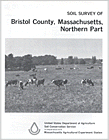Soil Survey of Bristol County, Massachusetts
NORTHERN PART

The following Map Unit Description is from the 1981 Soil Survey of Bristol County, NORTHERN Part. Please note: map unit symbols are DIFFERENT for Bristol North and Bristol South reports, do NOT use these descriptions for Bristol South.
UnA-Unadilla very fine sandy loam, 0 to 3 percent slopes. This soil is deep, nearly level, and well drained. It is on old lakebed deposits. The mapped areas are irregular in shape and are from 10 to 15 acres in size.
Typically, the surface layer is very friable, dark brown very fine sandy loam about 7 inches thick. The subsoil is very friable, yellowish brown very fine sandy loam about 21 inches thick. The substratum to a depth of 60 inches is very friable, yellowish brown loamy very fine sand.
Included with this soil in mapping are areas of Scio soil less than 4 acres in size. Also included are areas of Agawam and Amostown soils. The included soils make up about 20 percent of the map unit.
Permeability is moderate in the subsoil and slow to rapid in the substratum. Available water capacity is high, and soil reaction is very strongly acid to medium acid unless limed. The root zone extends into the very friable substratum.
This soil has good potential for farming, and most acreage is or has been farmed. It has good potential for most urban use and for sanitary waste disposal facilities. The soil has good potential for trees and for openland and woodland wildlife habitat. Some acreage has been developed for homesites or commercial use.
The soil is well suited to cultivated crops, hay, and pasture. Good tilth is easily maintained. The hazard of erosion is slight. Conservation management includes maintaining good fertility, improving tilth, and increasing organic-matter content. If the soil is farmed, the use of minimum tillage, cover crops, and grasses and legumes in the cropping system help maintain good tilth and increase organic-matter content. Proper stocking rates, deferred grazing, and pasture rotation are management practices that help to maintain desirable pasture plants.
The soil is well suited to trees. Productivity is high. Important tree species are eastern white pine and northern red oak.
The soil has few limitations for most urban use and for sanitary waste disposal facilities. Capability class I.
UnB-Unadilla very fine sandy loam, 3 to 8 percent slopes. This soil is deep, gently sloping, and well drained. It is on old lakebed deposits. Slopes are smooth and are generally 50 to 100 feet long. The mapped areas are irregular in shape and are from 5 to 25 acres in size.
Typically, the surface layer is very friable, dark brown very fine sandy loam about 7 inches thick. The subsoil is very friable, yellowish brown very fine sandy loam about 21 inches thick. The substratum to a depth of 60 inches is very friable, yellowish brown loamy very fine sand.
Included with this soil in mapping are areas of Scio soil that are generally less than 4 acres in size. Also included are areas of Agawam and Amostown soils. The included soils make up about 20 percent of the map unit.
Permeability is moderate in the subsoil and slow to rapid in the substratum. Available water capacity is high. Reaction is very strongly acid to medium acid unless limed. The root zone extends into the very friable substratum.
This soil has good potential for farming, and most acreage has been farmed. It has good potential for most urban use and for sanitary waste disposal facilities. The soil has good potential for trees and for openland and woodland wildlife habitat. Some acreage has been developed for commercial use or for homesites.
The soil is well suited to cultivated crops, hay, and pasture. Good tilth is easily maintained. The hazard of erosion is moderate. Conservation management includes controlling erosion, improving tilth, and increasing organic-matter content. If the soil is farmed, strip cropping, minimum tillage, use of cover crops, and incorporating grasses and legumes in the cropping system help to reduce runoff and control erosion. Mixing crop residue and animal manure into the plow layer helps to improve tilth and increase organic-matter content. Proper stocking rates, deferred grazing, and pasture rotation are management practices that help to maintain desirable pasture plants.
The soil is well suited to trees. Productivity is high. Important tree species are eastern white pine and northern red oak.
The soil has few limitations for most urban use and for sanitary waste disposal facilities. Capability subclass IIe.